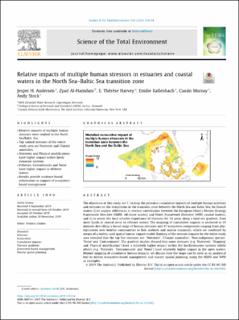| dc.contributor.author | Andersen, Jesper H | |
| dc.contributor.author | Al-Hamdani, Zyad | |
| dc.contributor.author | Harvey, E Thérèse | |
| dc.contributor.author | Kallenbach, Emilie | |
| dc.contributor.author | Murray, Ciarán | |
| dc.contributor.author | Stock, Andy | |
| dc.date.accessioned | 2020-07-03T10:23:38Z | |
| dc.date.available | 2020-07-03T10:23:38Z | |
| dc.date.created | 2020-03-16T11:23:47Z | |
| dc.date.issued | 2020 | |
| dc.identifier.citation | Science of the Total Environment. 2020, 704, 135316. | en_US |
| dc.identifier.issn | 0048-9697 | |
| dc.identifier.uri | https://hdl.handle.net/11250/2660688 | |
| dc.description.abstract | The objectives of this study are 1) to map the potential cumulative impacts of multiple human activities and stressors on the ecosystems in the transition zone between the North Sea and Baltic Sea, for Danish waters 2) to analyse differences in stressor contribution between the European Union’s Marine Strategy Framework Directive (MSFD, off-shore waters) and Water Framework Directive (WFD, coastal waters), and 3) to assess the local relative importance of stressors for 14 areas along a land-sea gradient, from inner fjords or coastal areas to offshore waters. The mapping of cumulative impacts is anchored in 35 datasets describing a broad range of human stressors and 47 ecosystem components ranging from phytoplankton over benthic communities to fish, seabirds and marine mammals, which we combined by means of a widely used spatial human impact model. Ranking of the stressor impacts for the entire study area revealed that the top five stressors are: ‘Nutrients’, ‘Climate anomalies’, ‘Non-indigenous species’, ‘Noise’ and ‘Contaminants’. The gradient studies showed that some stressors (e.g. ‘Nutrients’, ‘Shipping’ and ‘Physical modification’) have a relatively higher impact within the fjord/estuarine systems whilst others (e.g. ‘Fisheries’, ‘Contaminants’ and ‘Noise’) have relatively higher impact in the open waters. Beyond mapping of cumulative human impacts, we discuss how the maps can be used as an analytical tool to inform ecosystem-based management and marine spatial planning, using the MSFD and WFD as examples. | en_US |
| dc.language.iso | eng | en_US |
| dc.publisher | Elsevier | en_US |
| dc.rights | Attribution-NonCommercial-NoDerivatives 4.0 Internasjonal | * |
| dc.rights.uri | http://creativecommons.org/licenses/by-nc-nd/4.0/deed.no | * |
| dc.title | Relative impacts of multiple human stressors in estuaries and coastal waters in the North Sea–Baltic Sea transition zone | en_US |
| dc.type | Peer reviewed | en_US |
| dc.type | Journal article | en_US |
| dc.description.version | publishedVersion | en_US |
| dc.rights.holder | 2019 The Author | en_US |
| dc.source.pagenumber | 15 | en_US |
| dc.source.volume | 704 | en_US |
| dc.source.journal | Science of the Total Environment | en_US |
| dc.identifier.doi | 10.1016/j.scitotenv.2019.135316 | |
| dc.identifier.cristin | 1801803 | |
| cristin.ispublished | true | |
| cristin.fulltext | original | |
| cristin.qualitycode | 2 | |

